The Microsoft Surface Pro (2017) Review: Evolution
by Brett Howse on June 15, 2017 9:00 AM ESTGraphics Performance
With the Core i7-7660U, we finally get a chance to look at the Intel Iris Plus Graphics 640 in a notebook. On a typical U series Intel Core processor, there are 24 execution units (EUs) available, but the Iris Plus doubles that to 48. Despite having the same TDP, having twice as many EUs running should still be a big boost to performance, as even if they need to throttle, there are twice as many, so they can run slow and wide and still fit in the TDP. The base frequency for the graphics is 300 MHz, with a 1.1 GHz boost frequency.
The addition of 64 MB of eDRAM is also a large benefit to graphics, which needs a lot more memory bandwidth than the CPU, and having this extra eDRAM as a cache for the GPU is a big benefit to the Iris Plus graphics.
In the graphs below, make note that the Dell XPS 15 has a GTX 960M graphics card, which should win pretty handily, but the Surface Book has a smaller GT 940M with 2 GB of GDDR5, so it will be interesting to see the performance difference between the integrated Iris Plus Graphics 640, and a discrete entry-level GPU.
3DMark
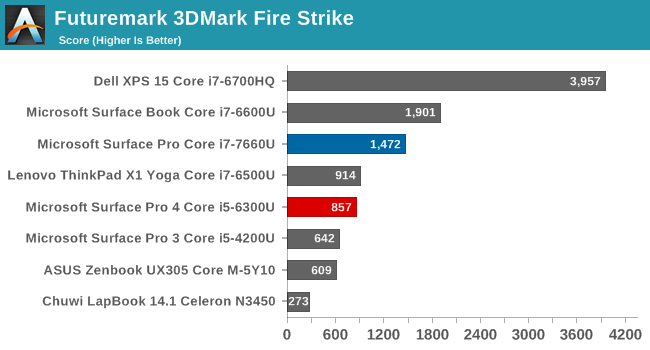
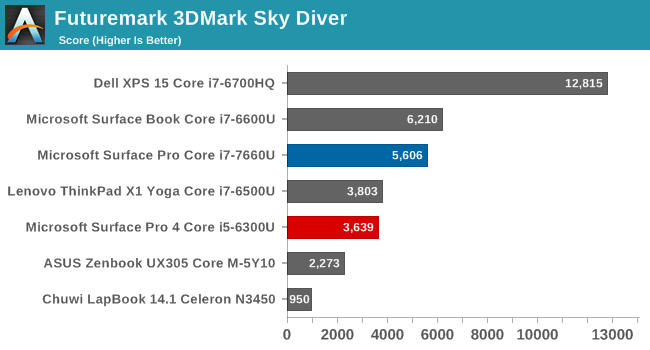


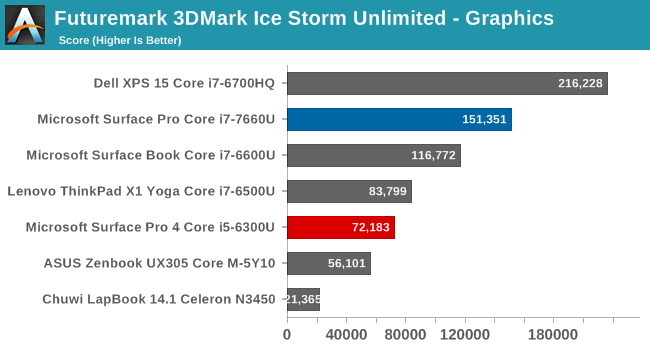
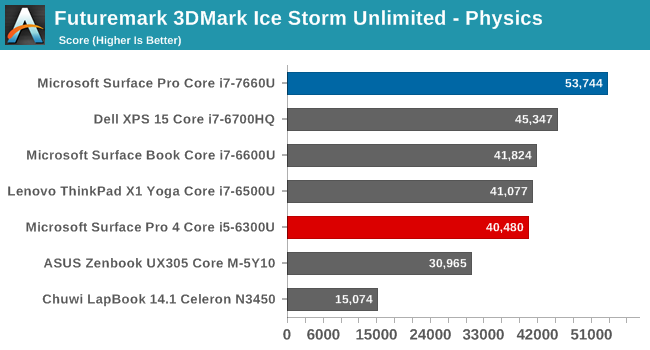
Futuremark’s 3DMark continues to be developed, and new tests have been added for higher end systems, but for our purposes on this review, the normal results will do just fine. Each of the tests move from quality to performance, with Fire Strike being the most demanding, and Ice Storm Unlimited being a smartphone or tablet test. The GT 940M in the Surface Book still manages to hold an edge on the more graphically demanding tests, but is then surpassed as the workload gets easier, and the test becomes more CPU bound. Compared to the non-Iris Ultrabooks though, the i7-7660U delivers a lot more performance.
GFXBench
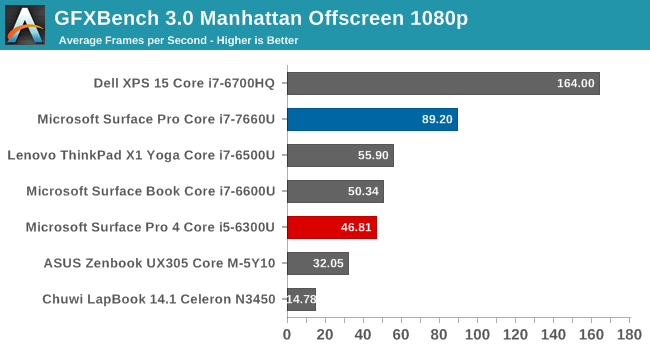

Another synthetic, Kishonti’s GFXBench also continues to evolve, with new tests being added to provide more stressful tests than the older T-Rex and Manhattan ones. Since we don’t have any comparison data, for now we’ll stick with the older tests while we fill out the data gaps. The Intel Iris graphics pull out a hefty lead here.
Dota 2
Valve’s Dota 2 online area game continues to be our go-to game for testing systems with lower end graphics, since it has a low barrier of entry, and is quite playable at low settings even on a system with integrated graphics.
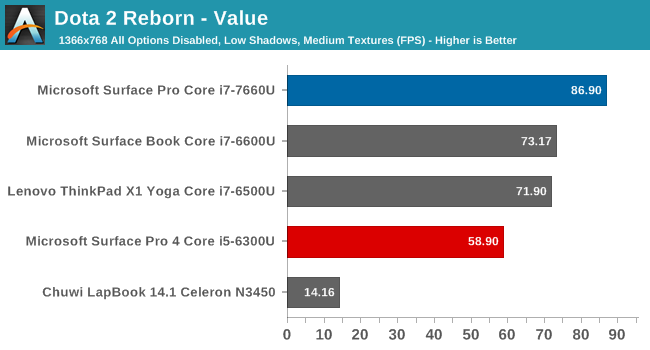
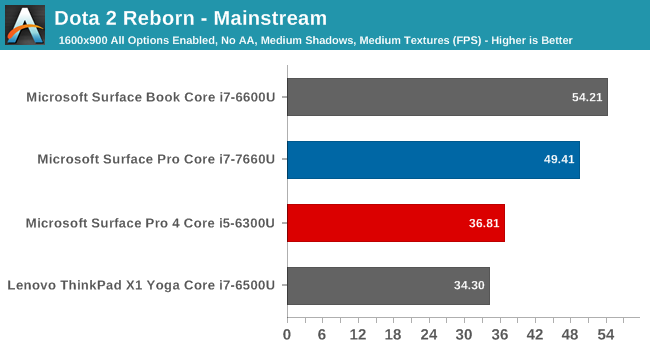
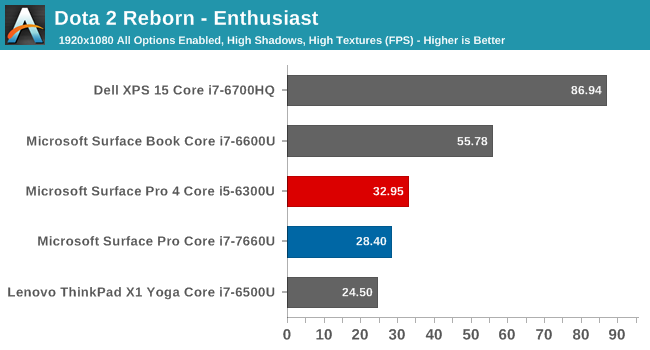
Here the Iris Plus Graphics do not bring the kind of improvement that would have been hoped for. At lower settings, they are very capable, and the extra CPU speed from the i7-7660U helps break the CPU bound barrier of the other systems, but once the graphics are turned up, the U series chip runs into the thermal barrier of only having a 15-Watt TDP. Compared to the Microsoft Surface Book, with it’s discrete GT 940M GPU, there’s really no contest, since that GPU alone would have 20-30 Watts of TDP available to it. The Iris does allow a lot more graphics potential, but for longer duration requirements, it may not offer much of an upgrade.
Graphics Conclusion
It’s great to finally be able to test a system with a U Series CPU and Iris graphics, and the results are quite impressive. It’s not quite up to par with even a low-end discrete GPU, but compared to the other integrated GPUs available in the other Ultrabooks, the Iris really brings the performance up a step. For light gaming, it should work well, but the extra eDRAM can help out on practically any task. The extra EUs available would also be of benefit to any productivity app that can leverage the GPU for some of its compute.
Storage Performance
PCIe SSDs have been the name of the game for the last couple of generations of Ultrabooks, but they’ve generally been shipping in the M.2 form factor. Microsoft has gone a different route with the new Surface Pro, by moving to a much smaller BGA SSD in the Samsung PM971.
The benefits of going this route are mostly packaging. The BGA SSD is significantly smaller than any M.2 SSD, especially the 2280 versions that are the most common. The drive is also most likely more energy efficient than the fastest SSDs available today, which should help with battery life.
There is likely only one downside to the PM971 BGA SSD, and that is performance. While still much faster than a SATA SSD, the PM971 is limited to a PCIe 3.0 x2 link, which is going to impact the maximum read and write speeds.
As you can see in the CrystalDiskMark test, the maximum read speed is well under something like a Samsung SM961. This may seem like bad news, but in fact the PM971 actually outperforms the same size PM951 drive which was easily the most popular SSD found in Ultrabooks until recently. The PM971 is 48 layer TLC NAND, with reasonable write speeds, and other than the lowered maximums created by the PCIe link being x2 instead of x4, the performance is quite good.
When you look at a device like the Surface Pro, where space is at a premium, these are the kinds of compromises that make sense when you consider that they’ve increased the battery capacity by 15%, and despite going with a compact SSD, they’ve still increased performance over the outgoing model assuming it had a PM951, which it seemed most did.


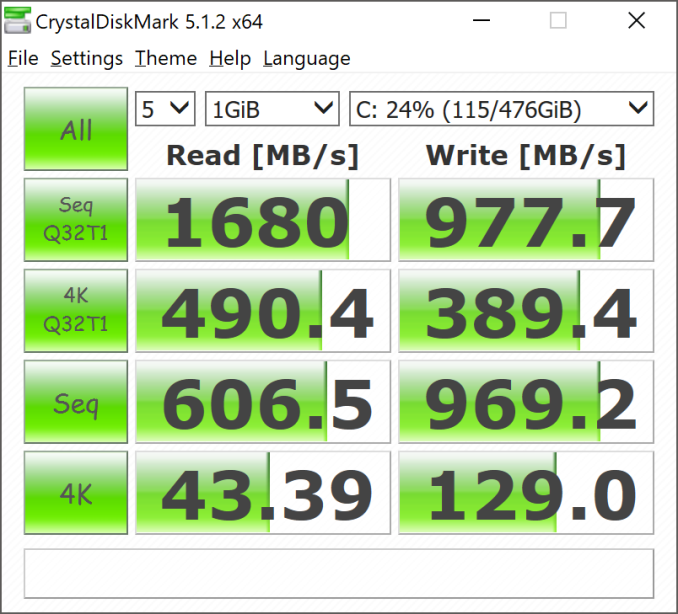








124 Comments
View All Comments
KPOM - Sunday, June 18, 2017 - link
The issue is that the iPad Pro runs an ARM-based OS while macOS is x64-based. Perhaps Apple could insist that developers write universal apps but they are not in as good a position as Microsoft to do so, since macOS is a niche OS.serendip - Thursday, June 15, 2017 - link
If this is Microsoft's take on evolution, I'd expect extinction soon. The Surface Pro is becoming like a panda - cute but close to an evolutionary dead end. No USB-C, no Thunderbolt, crazy expensive pen and keyboard...Apple can get away with niche products like the iPad Pro because it has Macbooks and Macbook Pros. Microsoft doesn't have that luxury, it only has the Surface Pro and Pro-derived Surface Book.
Kissmojo - Friday, June 16, 2017 - link
I have a Surface Pro 3, shipped with Windows 7 at the time, while the screen itself looks good, the multi touch is really not for Windows 7.Upgraded to Windows 10, had several firmware issues, including not powering up, freeze on boot screen... Returned to MS twice and they wiped the device twice... Now the device is still running on Windows 7, I had no intention to do the upgrade anymore, it's now sitting next to my TV...
Here's the point, the device looks slick and attractive, however I can never use it like an iPad, it's heavier, much less accessible in your hand. The Windows 10 overall is not touch friendly.
If you connect the type cover to use as a laptop, the kickstand cuts into your lap, if you put onto a desk, it feels flimsy, typing on the expensive type cover feels bad, it's a cheap and unreliable experience.
I would never buy this kind of computer again. At $2,000 USD, I would rather buy a iPad pro with a portable laptop.
Gunde - Friday, June 16, 2017 - link
Where did you get a Surface Pro 3 with Windows 7? They only ever shipped with 8.1 and 10.Hurr Durr - Friday, June 16, 2017 - link
It's a transparent crapple shill, come on.Gunde - Friday, June 16, 2017 - link
Probably, but it's just such a weird statement to make. It's not as if Windows 8.1 was wonderful for touch, as soon as you got out of the modern UI it was kind of hard to navigate without a pen.SaolDan - Friday, June 16, 2017 - link
I thought the exact same thing. I SMELL LIE.mkozakewich - Saturday, June 17, 2017 - link
Naw, the Surface RT 4 with Windows XP was my favourite platform ever. So intuitive!Kissmojo - Sunday, June 18, 2017 - link
Sorry, I was wrong, it's Windows 8 not 7, I was confused with the interface while writing.Kissmojo - Sunday, June 18, 2017 - link
Yes, it's running on Windows 8.1, I was confused while writing.